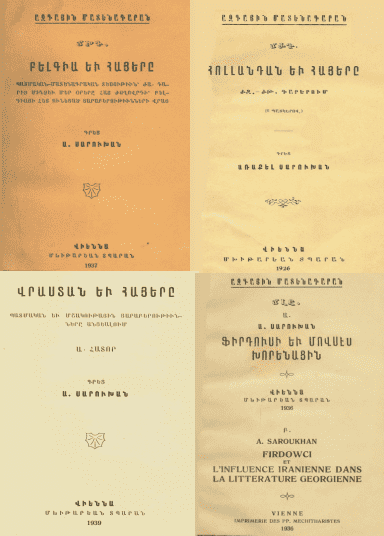Arakel Saroukhan (Saroukhanian) was a lesser known, but prolific historian and philologist.
He was born in the village of Ardanouch (district of Artvin), which was annexed to the Russian Empire after the Russian-Turkish war of 1877-1878 until 1921. He was a graduate of the lyceum of the Mekhitarists of Vienna in Constantinople, where he studied with the famous Armenian language scholar Fr. Arsen Aydenian. He returned to his birthplace and worked as a teacher. He contributed to the daily Mshak (Tiflis) from 1887 and to the journal Handes Amsorya of the Viennese Mekhitarists from its inception in 1887. He later wrote for the daily Arevelk of Constantinople. From 1894-1911, he was first agent and then director of the oil and trade company of famous businessman and benefactor Alexander Mantashian (Mantasheff) in Batum, Baku, Tiflis, and St. Petersburg, and then represented various foreign oil companies from 1911-1917.
He wrote the travelogues “The Russian Shore of the Black Sea” (1895) and “In the Caucasian Mountains” (1896), which contain valuable topographic, ethnological, and historical information about the Armenian communities of the Black Sea and the Caucasus, as well as local and immigrant people. In the book “The Armenian issue and the National Constitution in Turkey” (1912), Saroukhan presented the economic and political situation of the Ottoman Empire, the European diplomacy in the Armenian Question, the role of Armenian public figures in the Ottoman constitutional movement, et cetera. His memoir “Alexander Mantashian, the great trader and benefactor” (1931), Saroukhan gave information about the origin and development of the Armenian capital in the Caucasus, as well as the expansion of oil production in Baku.
After the October Revolution of 1917, Saroukhan moved to Europe and lived first in the Netherlands from the early 1920s, and then moved to Belgium. He wrote literary works, of which the most known is the realistic novel “The Mysterious Girl and Her Secret” (1924). He published many articles in Handes Amaroya about Armenian intellectuals of the nineteenth and early twentieth century, such as Rafael Patkanian, Raffi, Gabriel Sundukian, Perch Proshian, Grigor Artzruni, Leo, and others; the cultural institutions of the Armenians in the Caucasus, their political movements, etcetera. On the basis of archival material found in the Netherlands and Belgium, he wrote the monographs “Holland and the Armenians in the sixteenth-nineteenth centuries” (1926) and “Belgium and the Armenians” (1937), which contain a rich trove of information about Dutch-Armenian and Belgian-Armenian relations from the Middle Ages. Saroukhan also investigated the economic, political, and cultural relations of Armenians and Georgians (“Georgia and the Armenians,” 1939).
This prolific author passed away in Brussels (Belgium), on February 6, 1949.
